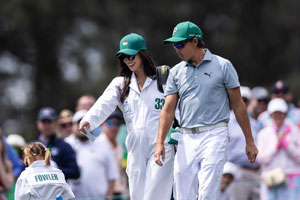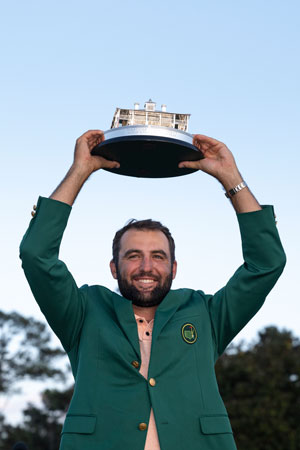
The world’s number one-ranked golfer and gusty winds blew away the 2024 Masters field.
Ferocious winds, firm fast greens and a fickle forecast that delayed the first round were just a few of the foes that the 89 golfers at the 88th Masters Tournament fought last year.
The rest of the field also had to contend with another force of nature in the world’s top-ranked golfer, Scottie Scheffler. He came to the tournament with two victories and a T-2 finish in his three previous PGA Tour starts leading into the Masters. He also had not shot a single round over par in the eight tournaments he had entered all season.
With a final score of 11-under that was four shots clear of runner-up Ludvig Åberg, a Swede who was competing in his first major, Scheffler left Augusta National Golf Club with his second green jacket in three years. Shooting 66-72-71-68 for the tournament, his string of par or better rounds remained intact as well.
“It’s hard to put into words how special this is. It’s been a long week, a grind of a week,” Scheffler said. “The golf course was so challenging, and to be sitting here wearing this jacket again and getting to take it home is extremely special.”
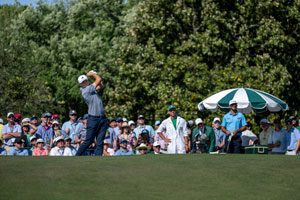 He began the fourth round with a one-stroke lead over playing partner Collin Morikawa, but after two bogies and a birdie through the first seven holes, Scheffler was tied for the lead with Morikawa and Åberg at 6-under. Morikawa was even par and Åberg, one of 20 first-timers in the field, had two birdies in the same stretch. Scheffler and Morikawa then birdied No. 8 for a tie atop the leaderboard at 7-under.
He began the fourth round with a one-stroke lead over playing partner Collin Morikawa, but after two bogies and a birdie through the first seven holes, Scheffler was tied for the lead with Morikawa and Åberg at 6-under. Morikawa was even par and Åberg, one of 20 first-timers in the field, had two birdies in the same stretch. Scheffler and Morikawa then birdied No. 8 for a tie atop the leaderboard at 7-under.
Scheffler seized the lead for good on the ninth hole when he birdied and Morikawa double bogeyed. With another birdie on No. 10 to reach 9-under, Scheffler extended his lead to two shots over Åberg and Max Homa. However, he felt like the eighth hole was key.
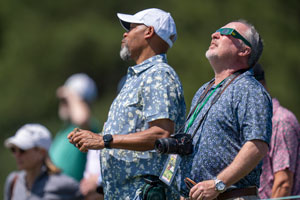 “The best momentum turner that I had today was the birdie putt on 8. … That gave me some good momentum, and I used that to birdie 9 and 10 and keep pushing because I knew there were birdies out there on back nine,” Scheffler said. “I had a lot of really talented players trying to chase me down, and I knew pars weren’t going to get it done.”
“The best momentum turner that I had today was the birdie putt on 8. … That gave me some good momentum, and I used that to birdie 9 and 10 and keep pushing because I knew there were birdies out there on back nine,” Scheffler said. “I had a lot of really talented players trying to chase me down, and I knew pars weren’t going to get it done.”
With a bogey on No. 11 and a birdie on No. 13, Scheffler played Amen Corner in even par while his closest competitors were over par on the three holes. Morikawa and Åberg were 1-over as both double bogeyed No. 11 and birdied the 13th hole. Homa, a stroke behind Scheffler, doubled No. 12 when his tee shot sailed long into the bushes behind the green, putting him at 2-over for the famous holes.
The final five holes were a formality as Scheffler breezed to victory. He continued to play aggressively on the back nine, battling until the end, and never let himself “get attached to the lead.” After Amen Corner, however, his main adversary was the golf course.
“Around this golf course you have to stay aggressive. You have to hit the right shots. There’s no way around it out here. You can’t play too defensive, and you can’t play too aggressive,” he said.
Before the winds kicked up and Scheffler started crafting Scheffler magic later in the week, another natural phenomenon appeared mid-afternoon during the Monday practice round. The area experienced a partial solar eclipse, and Augusta National distributed eclipse glasses – green with a Masters logo on each temple – to everyone on the grounds to view it.
“We took a look a few times as it was passing by. Pretty cool. You could tell the light – you could really notice a difference,” said Canadian golfer Adam Hadwin.
While the eclipse lasted about two-and-a-half hours, the length of the golf course was a topic of conversation during the Tuesday practice round. Prior to last year’s tournament, the Masters tees on the par-5 second hole had been moved back 10 yards and to the golfers’ left.
No. 2 looked “awesome,” Masters champion Fred Couples said. However, he added, “I don’t know if there’s any holes they need to lengthen.”
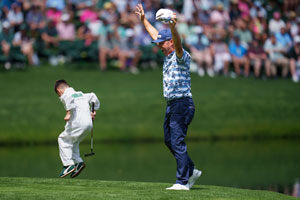 Two-time Masters winner Jose Maria Olazabal agreed.
Two-time Masters winner Jose Maria Olazabal agreed.
“I think the golf course is long enough, but if they want to, I’m pretty sure that they can find the space to do so,” he said.
Another Masters champion, Vijay Singh, said he thought the 12th hole should be lengthened. However, Olazabal thought the signature par-3 No. 12, the only hole at Augusta National that has never been lengthened, should be left alone.
“I think it’s a fantastic hole, great hole. It’s a short hole, but it’s a devilish hole. It’s very hard to hit the green. The green is at an angle. It’s not very deep. … When the wind blows, it’s a nightmare of a hole, and I think that hole is fantastic,” he said.
At his annual Wednesday morning press conference, Fred Ridley, the Masters Tournament and Augusta National chairman, said that adding distance to the golf course has become “standard operation” for the past 20 years.
“Each year we look for ways to improve the golf course to ensure it continues to challenge the best players in the world,” he said.
The chairman felt the adjusted tee location on No. 2 would give players something to consider on their second shots at the sloped dogleg left. He also said he likes No. 12 just as it is.
“I would say with a hundred percent certainty that it would not be lengthened during my tenure. That’s almost like asking, ‘Can we touch up the Mona Lisa a little bit?’ It is such an iconic hole that’s had so many important moments in the Masters that I’m not sure that another 10 yards would really make a difference,” said Ridley.
The afternoon gave way to light-heartedness and levity with the annual Par 3 Contest on Augusta National’s nine-hole, par-27 course. Only 16 of the 80 competitors posted complete scores, and Rickie Fowler won by shooting 5-under.
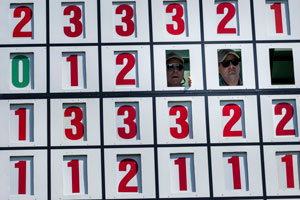 Wives, girlfriends, children and grandchildren serve as caddies in the beloved Masters tradition, and many players let their white jumpsuit-clad loopers hit a chip shot or knock in a putt.
Wives, girlfriends, children and grandchildren serve as caddies in the beloved Masters tradition, and many players let their white jumpsuit-clad loopers hit a chip shot or knock in a putt.
Five players took care of business with their tee shots by scoring holes-in-one, however. Sepp Straka of Austria aced No. 5; Augusta resident Luke List, Gary Woodland and Norway’s Viktor Hovland aced No. 6; and Lucas Glover had a hole-in-one on No. 7.
Difficult Scoring Conditions
The first round arrived on Thursday, but with the morning forecast calling for a 90% chance of rain and wind gusts of 40 to 45 mph, it was delayed 2 1/2 hours.
LIV golfer Bryson DeChambeau, New Zealand’s Ryan Fox and Byeong Hun An of Korea began the major with birdies on each of their first three holes. It marked the first time that three or more players made birdie or better on each of their first three holes in the first round at one Masters Tournament.
Round one was called at 7:51 p.m. due to darkness with 27 players still on the course, and it resumed at 7:50 a.m. Friday.
Carding eight birdies and one bogey for a 65, DeChambeau, who finished on Thursday, found himself atop the leaderboard with a score of 7-under.
Shooting 66 in the first bogey-free round of his Masters career, Scheffler was one shot back. He birdied three of the four par 5s, including the 13th hole when his second shot stayed up on the pin side of the creek bank. He also birdied No. 12 by holing out of the back bunker.
“I executed some really nice up-and-downs to keep the round going,” he said.
The winds had picked up during the day, and Scheffler, who dealt with gusty conditions on the back nine, said his caddie, Ted Scott, did “a really good job of kind of guessing the wind correctly.”
The second round began at 10:30 a.m. Friday, and the players grappled with extremely windy, challenging conditions. With gusts of up to 40 mph, sand from the bunkers whipped across the firm, fast greens and players’ golf bags toppled to the ground. At one point, the field was 200 strokes higher than it was the day before.
Two-time major champion Justin Thomas finished his round with double bogeys on Nos. 15, 16 and 18 and a bogey on No. 17 to miss the cut by a stroke. Other notables to go home early included Hovland and Masters champions Jordan Spieth and Dustin Johnson.
Initially projected at 4-over-par, the cut ultimately climbed to 6-over and sent some players who had cleaned out their lockers scrambling back to the course. The 60 players who made the cut included five-time Masters champion Tiger Woods. He played 23 holes on Friday and set yet another tournament record by making the cut for the 24th consecutive year. Hitting 25 of 28 fairways, he finished the first two rounds at 1-over.
After two days of difficult scoring conditions, only 14 players landed in red numbers. Scheffler, DeChambeau and Homa shared the 36-hole lead at 6-under-par.
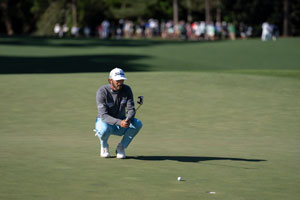 “The winds were up very high, and it blows from everywhere out here. I think even par this afternoon was a really good score,” Scheffler said. “It’s just so difficult when you can’t tell where the wind is coming from. You can only make really an educated guess and try to go from there.”
“The winds were up very high, and it blows from everywhere out here. I think even par this afternoon was a really good score,” Scheffler said. “It’s just so difficult when you can’t tell where the wind is coming from. You can only make really an educated guess and try to go from there.”
Super Power
The winds finally began to die down for the third round, but scoring didn’t get any easier. Scheffler’s hard-fought 71 – one of 12 scores under par on the day – included four birdies on Nos. 1, 3, 15 and 18, three bogeys on Nos. 4, 11, and 17, a double bogey on the 10th hole and an eagle on No. 13.
He fell two shots behind after the 10th and 11th holes but began to climb back up the leaderboard with a 7-foot putt to save par on the 12th hole.
After the eagle on No. 13 returned him to a three-way tie for the lead, the usually low-key, undemonstrative Scheffler allowed himself an emotional fist pump or four.
“That putt on 13 was nice because it was trickling up towards the cup. I didn’t know whether or not it was going to get there, and it kind of just nudged right over the edge and went in,” he said. “So it was exciting, and it was nice to be able to steal a couple shots there and get back in the tournament.”
Morikawa, with birdies on the first three holes and a score of 69, was one of only two players to shoot under 70 on Saturday.
The third round marked just the second time since World War II that Nos. 17 and 18 ranked in either order as the two most difficult holes during a Masters round. The 18th hole was the most difficult, but DeChambeau and Scheffler did their best to thwart that statistic.
After driving his ball into the trees on the right of the 18th fairway and punching out his second shot, DeChambeau holed a 77-yard wedge shot from the fairway for an unlikely birdie. Scheffler sank an 8-foot downhill birdie putt on the last hole to shoot 7-under and take sole possession of the lead going into the final round.
“It was a good fight out there. The golf course was extremely challenging. The greens were very firm, very fast, and it was extremely difficult again today. So probably looking for more of the same tomorrow,” Scheffler said.
Sunday was a sunny, “Greetings from Augusta” postcard kind of day, but the wind once again was a factor in the fourth round. Scheffler said he and his caddie “got the wind completely wrong” on the first three holes.
“I think you have to recognize in 72 holes, especially around here, you’re going to get wind shifts. … In the first four holes, I couldn’t get him on the green,” Scott said. “You just kind of know it’s going to happen, and he’s mature enough to recognize, when it does happen, it’s golf. It’s nothing you can control. … Maybe that’s his super power to be able to do that after carnage.”
Scheffler, who leaned on his short game, carded birdies on the 14th and 16th holes as well.
His victory marked the seventh time that the world’s top-ranked golfer entering the week won the tournament. He also became the second player, along with Woods, to win the Masters twice as the world’s No. 1 golfer.
“I try to compete to the best of my abilities. I really want to win. I feel like that’s how I was designed,” the two-time Masters champion said. “That’s always been a part of me, and I don’t think that should be going away anytime soon.”
By Betsy Gilliland
